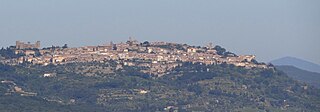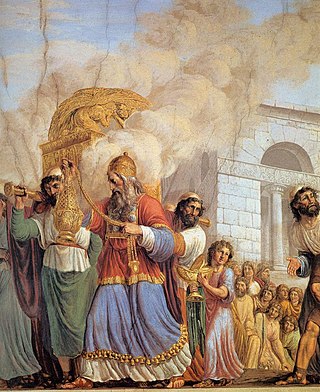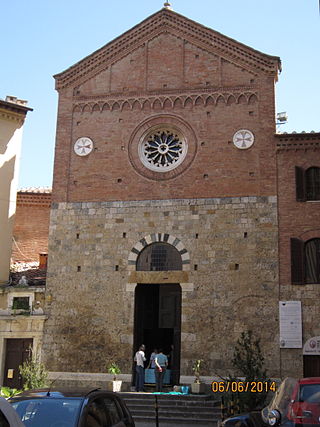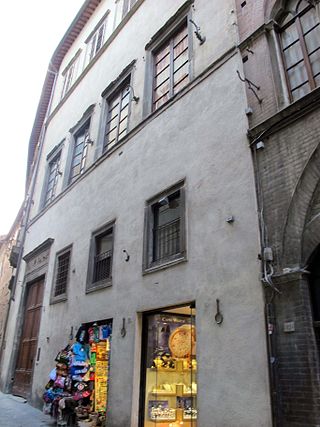
Montalcino is a hill town and comune in the province of Siena, Tuscany, central Italy.

The Palazzo Pitti, in English sometimes called the Pitti Palace, is a vast, mainly Renaissance, palace in Florence, Italy. It is situated on the south side of the River Arno, a short distance from the Ponte Vecchio. The core of the present palazzo dates from 1458 and was originally the town residence of Luca Pitti, an ambitious Florentine banker.

The Palazzo Pubblico is a palace in Siena, Tuscany, central Italy. Construction began in 1297 to serve as the seat of the Republic of Siena's government, which consisted of the Podestà and Council of Nine, the elected officials who performed executive functions.

The Pinacoteca Nazionale is a national museum in Siena, Tuscany, Italy. Inaugurated in 1932, it houses especially late medieval and Renaissance paintings from Italian artists. It is housed in the Brigidi and Buonsignori palaces in the city's center: the former, built in the 14th century, it is traditionally identified as the Pannocchieschi family's residence. The Palazzo Bichi-Buonsignori, although built in the 15th century, has a 19th-century neo-medieval façade based on the city's Palazzo Pubblico.

The Ducal Palace is a palace in Lucca, Tuscany, central Italy.

Palazzo Salimbeni is a Gothic style urban palace located on the Piazza Salimbeni, just off Via Banchi di Sopra in the Terzo di Camollia of the city of Siena, region of Tuscany, Italy. The building, associated with an ancient mercantile family of Siena, currently houses the main offices of the Banca Monte dei Paschi di Siena, the oldest bank in the world.

The Palazzo Serbelloni is a Neoclassical palace in Milan. The palace at the site was constructed for the aristocrat Gabrio Serbelloni. In the late 18th century, the palace was extensively reconstructed including the façade by Simone Cantoni. The palace was used in 1796 for three months by Napoleon and Josephine. The interiors retain some of the prior splendor, some reconstructed. The first floor has a Neoclassical hall, originally decorated by Giuliano Trabellesi. In 1943, air-raids destroyed extensive sections, including the famous library with its 75,000 books, and the frescoes by Traballesi.

Luigi Ademollo was an Italian painter.

Palazzo del Magnifico, also known as Palazzo Petrucci, built as the residence of Pandolfo Petrucci, is located in Siena on Piazza San Giovanni at the corner of Via dei Pellegrini.

The Palazzo Bichi Ruspoli, or previously Palazzo or Castellare dei Rossi, is an urban palace, located on Via Banchi di Sopra in the present contrada of Civetta, Terzo di Camollia of the city of Siena, region of Tuscany, Italy.

The Palazzo Spannocchi is a Renaissance style urban palace located on the Piazza Salimbeni, just off Via Banchi di Sopra in the Terzo di Camollia of the city of Siena, region of Tuscany, Italy. The building was associated with an ancient mercantile family of Siena.

The Palazzo Piccolomini, also known as the Palazzo Todeschini Piccolomini is a Renaissance-style palace in the city of Siena, region of Tuscany, Italy. It is located on the Banchi di Sotto, at the corner with Via Rinaldini; uphill and west of the church of San Martino, the Loggia del Papa, and the Palazzo delle Papesse, which also built by a Piccolomini family member.

The Palazzo Palmieri, or Palazzo Nuti, is a Mannerist style urban palace, located on Via del Moro #48 in the present contrada of Civetta, Terzo di Camollia of the city of Siena, region of Tuscany, Italy.

San Donato, also called San Michele al Monte di San Donato, is a Baroque style, Roman Catholic church located on the Piazza on Via dell'Abbadia, Siena, region of Tuscany, Italy. The Monte de Paschi di Siena, whose original offices were in the Palazzo Salimbeni, whose rear facade faces the church, has a Pinacoteca/Museum called San Donato.

The Palazzo Bindi Sergardi, previously Agostini and later Casini-Casuccini is, from the outside, a non-descript urban building located on Via dei Pellegrini # 18 in central Siena, region of Tuscany, Italy. The site is best known for containing frescoes by the late-Renaissance painter Domenico Beccafumi and Cristoforo Roncalli.

San Niccolò al Carmine, also called Santa Maria del Carmine is a Renaissance style, Roman Catholic church and monastery located in Pian dei Mantellini #30, near the corner of Via della Diana in the Terzo de Citta of Siena, region of Tuscany, Italy. The church now serves as the Oratory for the Contrada of Pantera. Across the street from the belltower is the Palazzo Celsi Pollini. North along Pian dei Mantellini, toward the Arco delle Due Porte, and on the same side of the street are a number of palaces built around what was once the Monastery of the Derelict Women: in order they are the Neoclassical Palazzo Incontri, the Palazzo Ravissa and the Palazzo Segardi.

The Palazzo Celsi Pollini, once also called the Palazzo del Vescovo, is a Renaissance style urban palace in Siena, Italy. It is located on Pian dei Mantellini #39-41, at the corner with Via San Quirico. A 19th-century source refers to the house as Casa Campioni. The main facade faces the campanile of San Niccolò del Carmine.

The Palazzo Francesconi, later Mocenni, is a 16th-century Renaissance urban palace located on Via del Cavallerizzo in the city of Siena, region of Tuscany, Italy.

The Palazzo Venturi Gallerani is an 18th-century palace on via delle Cerchia #6, near the Pinacoteca Nazionale in Siena, Tuscany, Italy. The palace is presently occupied by private residences.

The Palazzo Piccolomini-Clementini is a Gothic-style palace located on Via Banchi di Sotto #75 in the city of Siena, region of Tuscany, Italy. It is located across the street from the more imposing Renaissance-style Palazzo Piccolomini and the Loggia del Papa. The nearby Palazzo delle Papesse was also built by a Piccolomini family member.




















